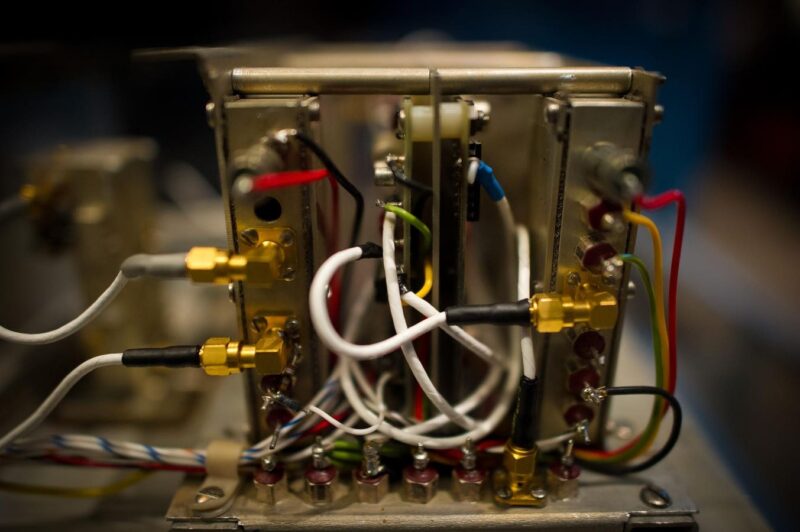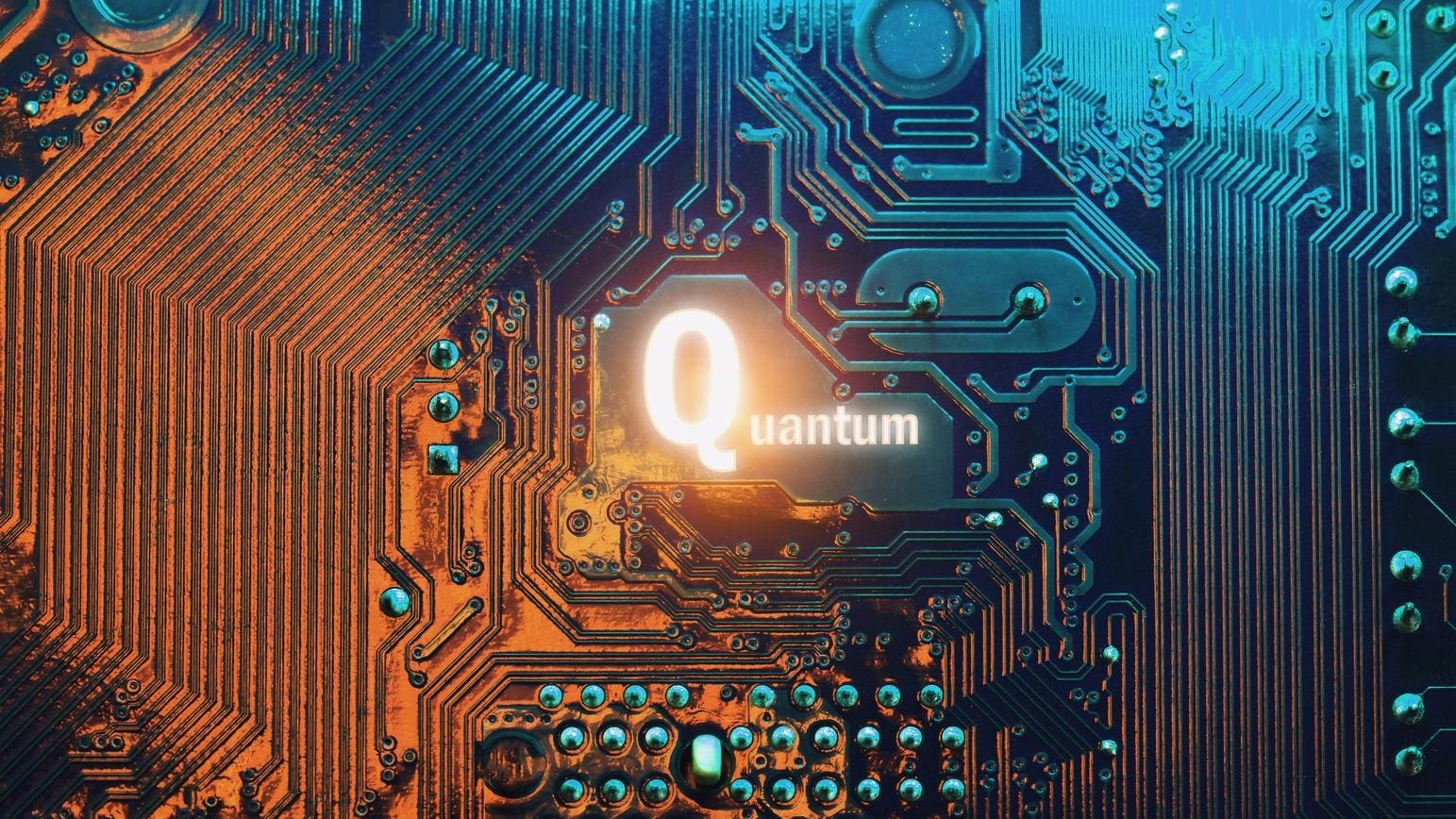The interior of a 1970 “atomic clock” designed to work in the space, exposed at the “Time and navigation” exhibition at the Smithsonian National Air and Space Museum in Washington, April 10, 2013. The exhibition explores how revolutions in timekeeping over three centuries have influenced how people find their way. This project is a collaboration between two of the Smithsonian’s largest and most popular museums: the National Air and Space Museum and the National Museum of American History. AFP PHOTO / MLADEN ANTONOV (Photo credit should read MLADEN ANTONOV/AFP via Getty Images)
AFP via Getty Images
As discussed in Part 1 of this article, DARPA (Defense Advanced Research Projects Agency), a U.S. Department of Defense (DoD, now the DoW Department of War!) organization recognized the threat of GPS denial/unavailability as a significant issue for PNT (Position, Navigation & Timing), and initiated a Robust Quantum Sensors (RoQS) program to mitigate these threats. Per a recent Lawrence Livermore Lab report, “Quantum sensing is advanced technology that uses the quantum properties of particles to measure time, gravity, and electromagnetic fields with orders of magnitude more accuracy and precision than non-quantum (classical) sensors”. DARPA views quantum sensing for PNT as a key technology to enable operation in GPS denied or unavailable environments. Quantum techniques are sensitive, internal to the vehicle platform and immune to jamming by adversaries.
Although not clear to mainstream audiences, quantum powered atomic clocks are the power house behind GPS satellites and have been for the past 50 years. GPS satellites, first launched in 1978, operate with a network of atomic clocks on the satellites, which maintain synchronization to a common time reference. This is critical in calibrating position with GPS signals (these timing signals are also critical for financial markets, energy plants and other activities on Earth). The atomic clock shown in the figure above is based on quantum principles – specifically it measures the vibration frequency of rare earth atoms, and uses this to measure time. As GPS satellites evolved and improved, so did atomic clocks and quantum sensing for PNT.
Quantum Sensing for PNT – Show Me the Money!
As part of the RoQS program, DARPA recently announced two contract awards worth US$24.4M to Australia-based Q-Ctrl. The first is to ruggedize their quantum sensing technologies and products for demanding real-world use cases like drones and terrestrial military platforms. The second award is to mature next generation technologies for maritime environments, specifically, gravimetric quantum navigation sensors. Lockheed Martin, a U.S. defense prime contractor, is a sub-contractor on this program.
Other defense agencies like the Silicon Valley-based Defense Innovation Unit (DIU, also a DoW entity) launched a Transition of Quantum Sensors program last year. As part of this initiative, QuINS (Quantum Inertial Navigation System) is focused on getting quantum PNT equipment out of the laboratory and onto the battlefield. and has awarded Lockheed Martin a contract. Q-Ctrl and California-based AOSense are sub-contractors.
A recent noteworthy development is the launch (August 2025) of the Boeing built X-37B spaceplane. One of the mission goals is to test groundbreaking technologies like quantum sensors for navigating in GPS-denied environments. It reportedly carries the world’s highest performing quantum inertial sensor ever used in space. According to a Linked In post by Vector Atomics (founded in 2018 by ex-AOSense employees), this development was a result of a 2-year joint effort with Honeywell under a DIU contract. After this momentous event, IONQ, a $22B publicly listed quantum technology company (focused on quantum computing, networking, and sensing) announced (September 17, 2025) its intent to acquire Vector Atomics for ~6M shares of IONQ stock (worth about $400M). The deal closed (October 7, 2025) and with an increase in IONQ stock price, is now worth $450M. Vector Atomics currently has ~75 employees, 29 patents (pending and granted), and a $200M backlog of U.S. government contracts. $6M/employee!
Venture investments in quantum sensing companies are on the rise. Apart from Q-Ctrl, MSquared (United Kingdom) and iXblue (France) are other venture-backed start-ups. Interestingly, AOSense and Vector Atomics have never raised venture funding, relying on U.S. government program awards to further their IP and products.
Lots of money, investments and needs! To make sure you always know where you are!
Quantum Sensors – How Do They Work?
So how does this quantum stuff work? It gets a bit dense, and you generally need to have won a Nobel prize (or aspire to it) to understand this fully, so no surprise, most people like me barely understand it. But I’ll try to explain as best I can (apologies in advance to quantum physicists who I have interviewed for this article).
Quantum sensors work by exploiting the quantum properties of atoms – superposition, entanglement and interference. But doing this, requires the gaseous elemental atoms to be cooled close to absolute zero (-460°F, -273°C, 0°K) where essentially all atomic or molecular motion ceases. One way to achieve this is counter-intuitive – using lasers. Optical energy at a specific wavelength (below the laser-cooling transition wavelength) injected into the gas of atomic vapor causes the latter to absorb photons from the laser and re-emit them, reducing their velocity and random vibrations (and their temperature). This particle movement can be minimized in all directions using a combination of lasers. Laser cooling has been an active area of research over the past 50 years, with the Nobel Prize in 1997 awarded to Steven Chu, Claude Cohen-Tannoudji and William D. Phillips “for development of methods to cool and trap atoms with laser light”.
Once you cool the atoms, you can use their properties to detect changes in acceleration, angular movement, magnetic or gravitational fields. Simple enough, hopefully! But practical realizations outside of a laboratory environment are complex (pesky engineering !). Constructing a Magento-Optic trap or enclosure is key – it consists of a vacuum enclosure (required to prevent air currents) which traps these atoms (typically rubidium or cesium), laser energy injection to cool the atoms, and creating a specific magnetic field environment. The resulting signals are very sensitive to the property it measures – but the sensitivity is a double-edged sword because the physical environment and the mounting platforms add noise and confound the signals. The physics of signals is well understood, noise not so much. But once methods or data to filter out the noise are developed, adn in a practical SWaP and price envelope), bingo. You’re golden, or quantum! Its exciting, but there there is still a long ways to go before we celebrate.
Types of Quantum Sensors for PNT
In essence, these fall into the following categories:
Inertial Measurement Units (IMU) are composed of accelerometers and gyroscopes and measure acceleration and rotation rates, respectively. IMU’s are a key component of Inertial Navigation Systems (INS) that process angular position and acceleration across 3 linear and 3 rotational axes. By starting from a known position, these changes integrated over time provide current location and bearing. Quantum IMUs use atomic interferometry, and can be used anywhere. Quantum inertial sensing is designed to complement existing PNT, preserving precision when external signals are degraded or denied.
Atomic Clocks measure time. These are critical for Quantum PNT systems, and also for time-keeping in GPS satellites.
Magnetometers measure a magnetic field, and use this to compare to pre-constructed maps of the Earth’s magnetic crust and geographical anomalies to determine location. Work on land and air, and maybe the ocean surface. Not in space, or underwater.
Gravimeters measure the strength of gravity, and compare to pre-constructed maps of the Earth’s gravitational fields to determine location. Work on land, air, ocean and underwater.
Quantum sensing for PNT cannot be jammed or spoofed since it relies on no external signals. The problem is that the high sensitivity of the cooled atoms to various physical effects listed above makes them very sensitive to platform noise, like vibration, temperature, weather and space events. Teasing out the signal from these noise sources is the challenge. In general, these techniques suffer from SWaP and price challenges, error drift, platform noise and limited operating windows (before accumulated errors become too large). Many companies and organizations are working on addressing these challenges. Specifically, both Q-Ctrl and AOSense are actively working on transitioning their sensor platforms from lab-to-field, typically with large defense primes like Boeing and Lockheed Martin who have the real-world platforms for testing, and practical experience in hardening and commercializing sensor systems.
Performance of PNT Quantum Sensors
Per the Lawrence Livermore report, when GPS works, the position precision is within 5 m (2m with Block III).
- Magnav can provide 100-1000 m position precision, depending on platform velocity and altitude, and algorithm correction for the vehicle’s magnetic field. Magnav degrades in geographies with minimal anomaly features and lower reference map quality/resolution.
- Gravimetric sensors provide precisions in the 2,000-10,000 m range. This estimate is based on early studies and constrained by limited by map quality.
- Quantum IMU’s are expected to perform much better in terms of drift rates. The goal according to Dr. Young of AOSense is to achieve an error of < 5 m after 24 hours of operation, which is significantly better (150X) than the best strategic grade mechanical IMUs
- Non-quantum IMUs accumulate errors that grow with time. These units could remain useful for about a few days, depending on navigation needs.
Tactical grade, typically used on found on unmanned arial systems (UASs) and guided weapons, costing ~ $50,000, drift rates between 18 and 37 km/hr.
Navigation grade: used on commercial and military aircraft, costing ~ $100,000, drift rates between 1,8 – 3.7 km/hr
Strategic grade: found on submarines, ships, and intercontinental ballistic missiles, costing ~$1 million dollars, drift rates between 30 and 100 meters/hr.
All IMUs units can remain useful for up to a few days, depending on navigation needs. At some point, GPS synchronization is still needed.
Q-Ctrl – We Make Quantum Useful
The company was founded in 2017 by Dr. Michael Biercuk, a quantum physicist from Harvard, and an ex-professor at the University of Sydney, Australia. The name is a riff on “Quantum Control” which it intends to do by delivering practical solutions for immediate real-world applications. The company has raised $133M to date, is shipping product to customers and has 160 employees. It counts Airbus Ventures and Bullhound Capital as key investors, and boasts significant pedigree on its advisory board (MIT, Caltech, UC Berkeley and UCLA).
Magnav (or magnetic navigation) is one area of focus for Q-Ctrl. It works best in geographies that have already been mapped for anomalies (interestingly, this was done by companies looking to exploit natural resources). According to Michael Biercuk, the challenges with deploying Magnav are:
Size, Weight and Power (SwaP): low SWaP is key for practical deployment. Most existing systems are very bulky and power hungry, and not amenable to edge computing and deployment on drones, missiles or ground vehicles.
Sensitivity and Stability: enabling anomaly identification without suffering from drift, noise, heading errors, or data instabilities is a challenge.
Platform noise: which reduces sensor sensitivity
Need for extensive calibration: accounting for variations in the anomaly maps due to altitude, space weather and diurnal magnetic field variations, and specific vehicle, payload, location and sensor position on the platform is a challenge that needs to be solved
Q-Ctrl addresses these challenges through a combination of SWaP optimized hardware (quantum sensors), sensor fusion algorithms (that combine data from quantum sensors with other on-board systems like INS), physical modeling and AI (artificial intelligence).
Figure 1 explains how Q-Ctrl’s magnetic quantum sensors work:
Figure 1: Left, Polarized Rubidium Atoms Change Orientation When Exposed to a Magnetic Field; Laser Source Changes Polarization When it Passes Through the Vapor. Right, Ironstone Opal, Low SwAP Quantum Magnetic Sensor
Q-Ctrl
Essentially, vapor state Rubidium atoms are vacuum-packed and polarized. Changes in ambient magnetic field cause the particles to rotate like tiny compass needles. A laser source interacts (low power 780 nm laser) with the polarized atomic vapor, causing polarization changes in the laser beam. This is detected by optical sensors. The signal is processed to extract position information of the vehicle. The key point is that this is a room temperature, compact, low power consumption sensor (low SWaP sensor head, ~ 60 cm³ volume, 15W power consumption) that fits into the nose cone of a drone, along with computing and communication hardware. It is also low cost enough to deploy on expendable platforms like drones or missiles, and performs better than a mechanical IMU, It adjusts to the individual eccentricities of a given vehicle quickly in operation so that laborious and time consuming calibrations are not required. Q-Ctrl claims that their software-hardware Magnav solution achieves as much as ∼46× better (lower) positioning error than velocity-aided INS, and at least 11× advantage across varying conditions, altitudes, and flight patterns. These trials were conducted at altitudes from ground level to ∼19,000 feet. In general, the sensor can operate completely independently without GPS providing an initial position, but the error is large (5 km vs GPS which provides position to within 3-5m). With initial position specified by GPS or visual references, it can navigate similar to a GPS without significant accumulation of error over distance and time.
Maritime applications (ocean or underwater) present different challenges, since there are noise sources from electrical currents in seawater that can interfere with magnetometers. For these applications, Q-Ctrl is developing a quantum sensor based on gravimetric navigation (GravNav). Similar to the magnetic signals emitted from the Earth’s crust, oceans emit gravitational fields which can be used in similar ways as Magnav. However, sensing this effect involves a large Magento-optical enclosure. Precision challenges are significantly more difficult. Figure 2 shows a ruggedized version of a quantum magnetometer and an experimental version under development of a quantum gravimeter. Q-Ctrl claims that it is a world-leader in fielded demonstrations of mobile gravimetry, although the results of these trials are not yet public. The DARPA contract in which Lockheed-Martin is a sub-contractor aims to further the gravimetric technology towards ruggedization, precision, miniaturization and practical realization.
Figure 2: Ruggedized Magnetometer (L), Gravimeter Solution Under Development (R)
Q-Cntrl
In the commercial realm, Q-Ctrl counts Airbus as one of its customers (Airbus Ventures is also an investor and on the Q-Ctrl board) and is currently working to test and characterize its software-ruggedized quantum sensors to provide the next generation of GPS backup on commercial aircraft. Dr. Biercuk vision for his company is “to apply software to transform the capabilities of quantum hardware with our world leading demonstrations of quantum navigation. Beyond this, from quantum computers in data centers to GPS backups in commercial aircraft and drones, Q-CTRL will be instrumental in ensuring it actually works”.
AOSense – Sensors for A Quantum World
The company was founded in 2004 by Brenton Young (doctoral research at Stanford under 1997 Nobel Laureate Steven Chu, who invented methods to cool and trap cold atoms using lasers). Professors James Spiker (Stanford, a GPS expert) and Mark Kasevich (Stanford, quantum sensing expert) joined as co-founders in 2006 to help accelerate AOSense’s growth. The company is profitable, has 38 employees, and self-funded through multiple grants from DARPA, Air Force, and other government and commercial entities over the past 20 years. It also ships products to a variety of customers. Also noteworthy is that Vector Atomics (recently acquired by IONQ for $450M) was founded in 2018 by former AOSense employees.
One area of focus for AOSense is the development of quantum accelerometers and gyroscopes, and combining these into a 6 degree of freedom IMU, see Figure 3:
Figure 3: Left: QuIMU (Quantum IMU) Architecture, ≈ 100 L Volume for World’s First Field Demonstrations (2023-2024) Right: 16X Size Reduction by 2030 to 6L Volume
AOSense
These IMUs use atom interferometry to detect rotation and acceleration using laser cooled atoms, providing navigational accuracy and precision without a GPS reference. The principles are extremely dense and beyond my capabilities to explain simply, but this paper provides an explanation of the deep physics behind it (Good Luck!) It consists of three quantum inertial sensors, each of which measures single-axis accelerations and rotations of the platform it is mounted on.
One of the challenges in lab-to-field transition is SWaP reduction. Brenton Young’s goal is to shrink the volume from the current 100L (100,000 cm³) to 6L (6000 cm³) by 2030. The current IMU consists of 8L occupied by the triangular sensor head, with the 3 controller boxes occupying 90L (Figure 3, Left). There are optical, electrical and data interconnections between the controller boxes and the sensor head (not observable in Figure 3 due to confidentiality reasons). In the SWaP reduced version (Figure 3, Right) the 90L occupied by the controller boxes is replaced by an integrated QuIMU controller that fits together with the sensor head in the new 6L QuIMU package (target date 2030). This reduction is achieved by eliminating duplicated optical and electronic components along different axes, and also getting rid of empty space in the controller boxes. This has been done by AOSense for other quantum sensors, and its a matter of funding and customer needs.
Application-specific integrated circuits (ASICs), monolithic microwave integrated circuits (MMICs), and photonic integrated circuits (PICs) can enable further reductions in size, power consumption and production cost, although per Dr. Young, this is not an absolute prerequisite for demonstration of a low-volume engineering prototype.
Reducing SWaP while maintaining performance is tricky because in a more confined vacuum envelope, atoms can hit the enclosure walls which makes them useless for further sensing. The reason is the messy Heisenberg uncertainty principle which posits that simultaneously measuring position and momentum of atoms is not possible (a corollary to this is the inverse relationship between measurement error and measurement time, which means that lower the time available for measurement, higher the measurement error). Low SWaP constrains the measurement time available.
Per Dr. Young, “the stable and well-defined properties of individual, neutral atoms in freefall in vacuum enabled laboratory atomic clocks to surpass the performance of astronomical and mechanical clocks. Subsequent atomic clock development has improved performance and transitioned them to adverse environments such as GPS satellites and military platforms. Now quantum-atomic sensors are leveraging those same exquisite atomic characteristics to revolutionize inertial navigation, gravimetry, magnetometry, and electrometry”.
AOSense collaborated with Boeing to demonstrate the world’s first six degree-of-freedom quantum IMU operation on ground vehicles in 2023, and a flight platform in 2024. Further sensor engineering soon will complete the transition of quantum-atomic sensors to fielded platforms, enhancing navigation accuracy in GPS-denied environments.
AOSense’s Collaboration with Boeing
Apart from SWaP, another challenge for lab-to-field transfer for quantum IMUs is to ruggedize the sensor and test it on different platforms to characterize performance, and very importantly, platform noise. AOSense worked with Boeing to test the IMU as part of a INS system on a truck in 2023. In 2024, it tested the IMU in an aircraft platform, again with Boeing.
The trials with Boeing in 2023-2024 were conducted under a $11M DARPA Precision Inertial Navigation Systems (PINS) program, and its successor, the HiDRA (High Dynamic Range Atom Sensors) Program awarded to AOSense. These programs were initiated at DARPA by Jay Lowell in 2012 (when he initiated and led the PINS program). Mr. Lowell is currently Chief Engineer and Senior Director at Boeing Research and Technology (BR&T). He led the recent collaboration with AOSense to demonstrate the latter’s quantum inertial measurement unit (QuIMU) on terrestrial and aerial platforms.
The 6-axis IMU (Figure 3, Left) was integrated into an inertial navigation system (INS) and deployed on a Beechcraft 1900D for a series of flight tests. The Boeing/AOSense team built the IMU/INS in 15 months, using AOSense’s basic quantum building blocks of three single-axis sensors and delivering a quantum IMU operating in flight (refer Figure 3, Left). This test also carried high-performance (strategic grade) mechanical IMU sensors, and had functioning GPS as a baseline to compare Quantum IMU/INS performance against. Design iterations based on laboratory, ground vehicle and flight tests data were used to to increase the sensor’s capability and reliability. The 2024 flight demonstrated that the quantum sensor based IMU was successfully able to navigate on its own for 4 hours without GPS.
Figure 4: (L) Team Members from HRL, Boeing and AOSense pose in front of flight aircraft (R) Team working on board the flight test, monitoring navigation data.
Boeing
According to Dr. Lowell, the key challenge with quantum IMUs as they transition from lab-to-field are platform noise sources (primarily vibrations) which create confounding effects in processing the the final signal to extract the platform’s kinematic coordinates. Outer space and underwater environments are more benign in this respect. Choppy ocean waters, helicopters, aircraft and bumpy terrestrial terrains are challenging. Extracting reliable performance across different platforms and physical environments requires collecting enough data and signal processing to understand how to correct for platform effects without compromising the signal. The challenge is to characterize QuIMUs over a large variety of moving platforms and conditions, and hopefully reach a point which makes it a universally deployable, calibrated sensor (just like mechanical IMUs are today). It is not clear whether AI algorithms can be/are used to do this, but probably should be.
Dr. Lowell: “Our aim is to mature quantum inertial sensing into a deployable and platform‑optimized capability. We’re committed to rigorous field testing in representative, demanding conditions to surface and solve early engineering challenges. This approach will advance the technology as rapidly and responsibly as possible”.
Lockheed Martin’s Role in Quantum Navigation
As mentioned earlier, Lockheed Martin has been awarded a contract by the U.S. Department of Defense’s Innovation Unit (DIU) to prototype and harden quantum-enabled INS for real-life applications, providing precise location measurements even in environments without access to GPS. For this contract, AOSense will provide the quantum IMU system (Figure 3) while Q-Ctrl will provide the software expertise to extract the relevant signals for the INS system. Lockheed Martin will provide the platforms for testing, algorithms to filter out platform noise, INS system expertise and experience with sensor hardening for relevant environments.
Per Dani Couger, Quantum Lead at Lockheed Martin, “Our partnership with Q-CTRL and AOSense in support of customers at DARPA and DIU enables the development of robust quantum-enhanced navigational technology. These programs represent validation by our customers that our team is in the position to mature the potential for quantum navigation solutions that are set to deliver transformational national security capabilities that complement GPS.”
As Part 1 of the article discussed, GPS and LiDAR techniques for PNT are improving, but threats remain. Quantum sensor-based PNT is an attractive solution that preserves operational continuity in GPS-denied environments in terrestrial, aerial, outer space, maritime and underwater domains.









